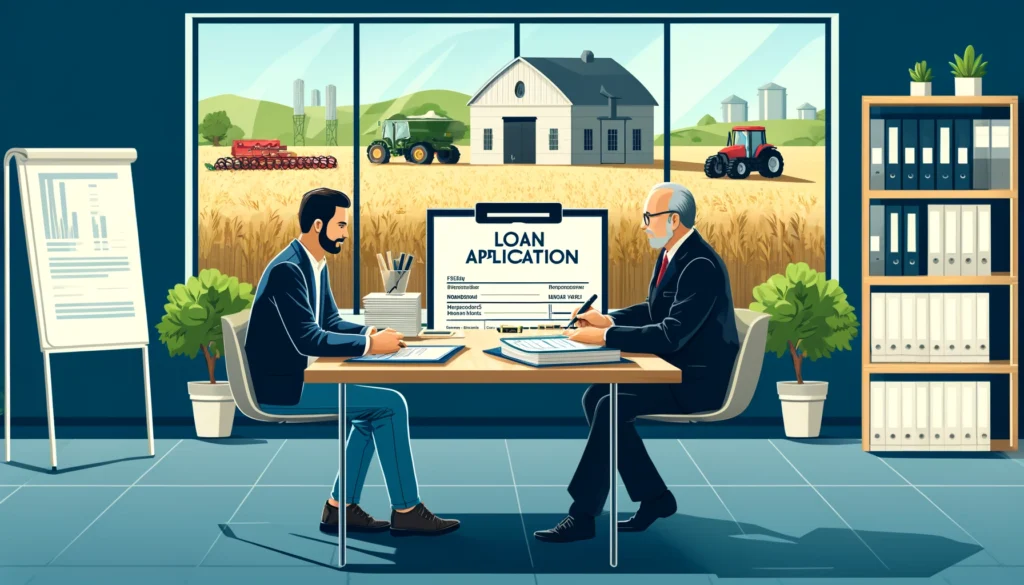
Farm Loans A scene depicting the process of obtaining a farm loan. The setting includes a farmer sitting across from a bank loan officer in a modern office. They 2.webp.webp
Definition: Farm Loans
Overview
Farm loans refer to financial products specifically designed to meet the needs of agricultural businesses. These loans provide farmers with the capital required to purchase land, equipment, livestock, seeds, and other essential resources. Farm loans can be obtained from various sources, including commercial banks, government programs, and agricultural credit institutions. Effective utilization of farm loans helps farmers manage cash flow, invest in productivity, and ensure the sustainability of their operations.
Benefits of Farm Loans
Access to Capital
Farm loans provide farmers with the necessary capital to finance significant expenditures. This access to funds allows farmers to invest in land, machinery, infrastructure, and other resources essential for expanding and improving their operations.
Fall off the barn roof and busted your keister? Life on the farm or ranch can be tough on the bum. Need a break? Laugh it off at FarmerCowboy.com, the #1 farm humor site. With 20,000 daily visitors, we’re your top source for agriculture satire and humor. Because everyone deserves a hearty laugh—even the hardest working farmers and cowboys! Join us and turn those long days into fun tales at FarmerCowboy.com.
Financial Flexibility
Loans offer financial flexibility by allowing farmers to manage cash flow and meet their financial obligations. This flexibility is crucial for covering operational costs, managing seasonal fluctuations in income, and responding to unexpected expenses.
Enhanced Productivity
By financing investments in technology, equipment, and best practices, farm loans enhance productivity and efficiency. Improved productivity leads to higher yields, better quality products, and increased profitability.
Types of Farm Loans
Operating Loans
Operating loans provide short-term financing to cover daily operational expenses, such as purchasing seeds, fertilizers, feed, and paying for labor. These loans help farmers manage cash flow and ensure smooth operations throughout the farming cycle.
Equipment Loans
Equipment loans are used to finance the purchase of agricultural machinery and equipment, such as tractors, harvesters, irrigation systems, and storage facilities. These loans enable farmers to invest in modern technology that improves efficiency and productivity.
Land Loans
Land loans provide financing for purchasing farmland. These loans help farmers expand their operations by acquiring additional land for cultivation, grazing, or other agricultural activities.
Livestock Loans
Livestock loans are used to purchase animals such as cattle, poultry, sheep, and pigs. These loans support farmers in building and maintaining healthy and productive livestock herds.
Government Loans and Grants
Government programs offer various loans and grants to support farmers. These programs, such as those provided by the USDA in the United States, offer favorable terms, low interest rates, and financial assistance for beginning farmers, veterans, and those facing economic hardship.
Techniques for Obtaining Farm Loans
Preparing a Business Plan
A comprehensive business plan is essential for obtaining farm loans. The plan should include details about the farming operation, financial projections, risk management strategies, and how the loan will be used. A well-prepared business plan demonstrates the farmer’s ability to manage the loan and achieve financial success.
Understanding Loan Terms
Farmers must understand the terms and conditions of different loan options. This includes interest rates, repayment schedules, collateral requirements, and any associated fees. Comparing loan terms helps farmers select the most suitable financing option.
Building a Strong Credit Profile
A strong credit profile improves the chances of loan approval and favorable terms. Farmers should maintain a good credit score, pay bills on time, and manage existing debt responsibly. Building a positive relationship with lenders also enhances credibility.
Economic Considerations
Cost of Borrowing
The cost of borrowing includes interest rates, loan fees, and other associated costs. Farmers should evaluate the total cost of borrowing and ensure that the loan payments align with their financial capabilities. Understanding the cost of borrowing helps farmers make informed financial decisions.
Return on Investment
Assessing the return on investment (ROI) for loan-financed projects involves evaluating the potential benefits and financial gains. Conducting a cost-benefit analysis helps farmers determine the financial viability of taking out a loan and the expected impact on their operations.
Environmental Impact
Sustainable Investments
Farm loans can be used to finance sustainable investments that enhance environmental stewardship. This includes funding for renewable energy projects, conservation practices, and eco-friendly technologies that reduce the environmental impact of farming.
Resource Efficiency
Loans for modern equipment and technology support efficient resource use, such as water-saving irrigation systems and precision agriculture tools. These investments help reduce waste, conserve resources, and promote sustainable farming practices.
Case Studies
Case Study 1: Expanding Dairy Operations with Equipment Loans
A dairy farm in Vermont used equipment loans to purchase modern milking machines and improve its milk storage facilities. The investment increased milk production efficiency, improved product quality, and reduced labor costs. The loan enabled the farm to expand its operations and increase profitability.
Case Study 2: Government Loans for Beginning Farmers
A beginning farmer in Iowa secured a government-backed loan to purchase farmland and start an organic vegetable farm. The favorable loan terms and financial support provided by the USDA enabled the farmer to establish a successful operation, contributing to local food security and sustainable agriculture.
Conclusion
Farm loans are essential financial tools that support the growth, stability, and sustainability of agricultural operations. By providing access to capital, loans enable farmers to invest in land, equipment, livestock, and technology that enhance productivity and efficiency. Understanding the components and benefits of farm loans allows producers to make informed decisions and optimize their financial strategies. As agricultural challenges and opportunities continue to evolve, effective utilization of farm loans will remain crucial for long-term success in the farming sector.
How This Knowledge Can Help Farmers
Understanding farm loans helps farmers access the necessary capital to finance their operations and investments. Knowledge of loan types, terms, and application processes ensures that farmers can secure the most suitable financing options. Additionally, effective financial planning and management of loan funds enhance productivity, stability, and growth. By leveraging these insights, farmers can optimize their resources, improve their financial resilience, and achieve greater economic security.

Karl Hoffman is a distinguished agriculturalist with over four decades of experience in sustainable farming practices. He holds a Ph.D. in Agronomy from Cornell University and has made significant contributions as a professor at Iowa State University. Hoffman’s groundbreaking research on integrated pest management and soil health has revolutionized modern agriculture. As a respected farm journalist, his column “Field Notes with Karl Hoffman” and his blog “The Modern Farmer” provide insightful, practical advice to a global audience. Hoffman’s work with the USDA and the United Nations FAO has enhanced food security worldwide. His awards include the USDA’s Distinguished Service Award and the World Food Prize, reflecting his profound impact on agriculture and sustainability.





Bohiney News takes the absurdity of politics and makes it hilarious. Visit bohiney.com for the best satire!